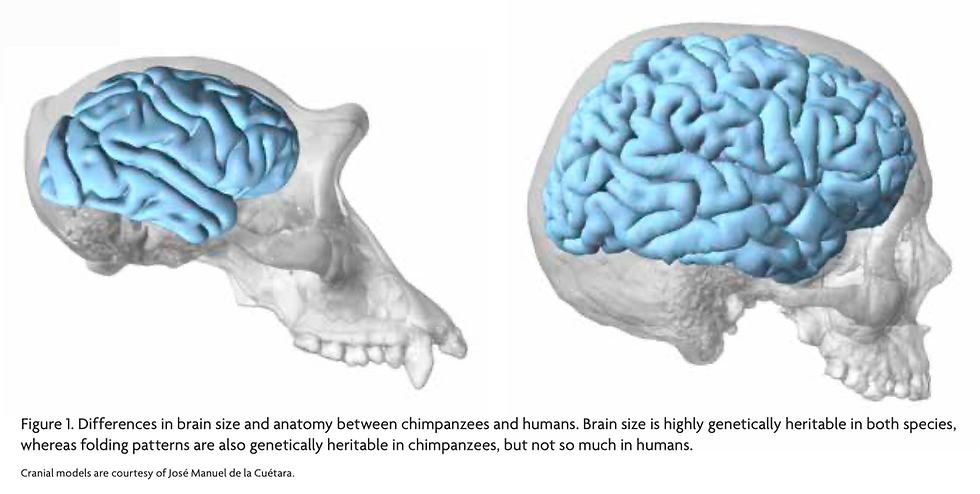Domain-General Mechanisms as Specialized Adaptations
- Wu, Bozhi

- Aug 8, 2019
- 4 min read
Updated: Mar 19, 2021

When thinking about all the psychological mechanisms we possess, we often differentiate the so-called domain-specific mechanisms from the domain-general (general-purpose) ones, where “domain” refers to a certain kind or form of input/information from the environment. However, whether we really have domain-general mechanisms that do not specify the form of input and can freely operate within a huge variety of conditions is still under debate. And in this short article, I would like to briefly summarize the two opposite views and conclude in support with professor H. Clark Barrett’s view, which has been clearly expressed through the title of this article. The motivation of writing this article comes from reading professor Barrett’s book The Shape of Thought: How Mental Adaptations Evolve, and this article is by no means an objective and thorough review of this problem, as I am just trying to express my superficial understanding toward this problem.
For most evolutionary psychologists, our mind is an extremely complicated assemblage of numerous domain-specific psychological mechanisms, “designed” by natural selection to solve the adaptive problems our ancestors faced in the past. The most common example will be the emotion of fear, which is a very conserved trait shared in almost all mammals. Fear is commonly elicited by certain specific kinds of stimuli and will almost always lead to similar sets of physiological responses and behaviors. Similarly, evolutionary psychologists view all facets of our mental activities as specialized adaptations, which implies that each of them should be specialized for processing a limited range or domain of inputs.
Nonetheless, some people argue that, unlike other animals, humans are exceptional as we have the ability to think (generally speaking) and the intelligence to flexibly utilize our mental capacities to solve all kinds of problems we face in our daily life. Here, the key term is “flexibility.” Unlike the example of fear mentioned above, which has very specific elicitors and responses, they contend that humans have also evolved domain-general mechanisms that lead to our daily thinking and other information processing. These mechanisms can be applied to deal with a huge variety of inputs and can flexibly generate the most appropriate responses. And in terms of brain anatomy, they are plausibly located in our neocortex, evolved relatively late in the evolutionary process (probably as a derived trait of humans).
At first glance, this distinction between domain-general and domain-specific seems to be plausible, as we do have certain mental activities that are rather “innate,” “specialized,” “canalized,” and others more “general,” “flexible,” “unrestricted.” However, there exist some underlying presumptions, or probably misconceptions about the concepts of innateness and specialized adaptations.
Honestly speaking, I think as long as one has some basic understanding towards how genes work and the relationship between genotype and phenotype, the misconceptions should not exist. Due to recent advancement in genetics and biology, now we have a more accurate understanding of the functioning mechanisms behind the most mysterious and wonderful codes nature utilizes to build all living creatures in this world – DNA. And the most important finding we have got throughout all these years is that “this thing is really, really complicated…” Personally, I am always amazed by how all the structural and functional components of our bodies are built up and regulated by these tiny genes. Whatever, this is a little bit off the track. What I want to stress is that genes do not necessarily need to encode for something that is very specified or limited in function, and it can certainly build something that can navigate through the environment and flexibly adapt to it.
Our brain has 86 billion neurons inside it, which form the most complicated network we have ever seen that generates all the activities we are having every day. And as we can see, we have developed certain innate capacities that are not as specified as fear, but more flexible, including learning. Although some people might say these are definitely instances of domain-general mechanisms, professor Barrett argues that these might also be specialized adaptations, and the reason for why people are reluctant to view them as specializations is simply due to their misconception that specialized adaptations must be limited (specified to a narrow range of inputs and generate limited outputs). In fact, it is perfectly reasonable for us to view learning as another instance of specialized adaptation that is particularly evolved for animals like us to survive and reproduce better within the fast-changing environment. It is not difficult to see how learning as an adaptation can increase an individual’s fitness. In other words, there is no reason for us to consider mechanisms like thinking and learning to be some kind of domain-general mechanisms that lack concrete evolutionary pathways for them to evolve. Instead, we should view them also as specialized adaptions, taking some rather different forms in order to deal with the changing environment and increase individual’s flexibility.
To conclude, domain-general mechanisms should also be treated as specialized adaptations, and they are also in a way domain-specific. There does not really exist authentic domain-general mechanisms, but only domain-specific ones with relatively wide domains. Besides, there is also the distinction between proper domain and actual domain, which is probably out of the scope of this article, but this is certainly relevant to the current discussion.
Bibliography
Barrett, H. C. (2015). The shape of thought: how mental adaptations evolve. New York: Oxford University Press.







Comments